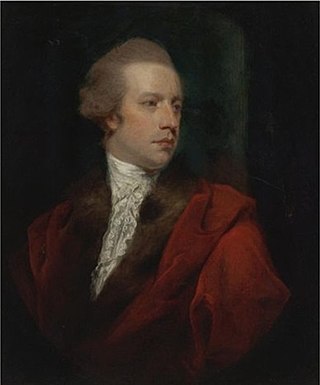Related Research Articles

Coutts & Co. is a British private bank and wealth manager headquartered in London, England.
Backhouse's Bank of Darlington was founded in 1774 by James Backhouse (1720-1798), a wealthy Quaker flax dresser and linen manufacturer, and his sons Jonathan (1747-1826) and James (1757-1804).

Charles William Bigge was an English merchant and banker in Newcastle upon Tyne.
Adam Drummond, 11th of Lennoch and 4th of Megginch in Perthshire, was a Scottish merchant, banker and politician who sat in the House of Commons between 1761 and 1786.

James Losh (1763–1833) was an English lawyer, reformer and Unitarian in Newcastle upon Tyne. In politics, he was a significant contact in the North East for the national Whig leadership. William Wordsworth the poet called Losh in a letter of 1821 "my candid and enlightened friend".

Henry Perlee Parker (1785–1873) was an artist who specialised in portrait and genre paintings. He made his mark in Newcastle upon Tyne in the 1820s through patronage by wealthy landowners and through paintings of large-scale events of civic pride. Over a period of forty years his work was exhibited at the Royal Academy and the British Institution in London. Coastal scenes of fisherfolk and smugglers were a popular specialism. Through the distribution and sale of mezzotint prints of subjects such as William and Grace Darling Going to the Rescue of the SS Forfarshire, Parker became one of the north-east's best-known nineteenth-century artists. In Newcastle upon Tyne he was central to the setting-up of a Northern Academy for the Arts. Later, in Sheffield, he taught drawing at the Wesleyan Proprietary Grammar School, and in his later years he lived in Hammersmith, London. He had a large family and was married three times.
Thomas Hanway Bigge was an English banker in Newcastle upon Tyne. The Bigge family were gentry based at Longbenton in the later 18th century, and are well documented; but Thomas Hanway Bigge has been confused with another member of the family, Thomas Bigge (1766–1851), who had moved to the London area by about 1810.
The Oeconomist, full title The Oeconomist, Or, Englishman's Magazine, was an English monthly periodical at the end of the 18th century. It was published in Newcastle upon Tyne, and was edited by Thomas Bigge, in partnership with James Losh.
Thomas Maude (1801–1865) was an English clergyman, writer and poet.

The Hawks family was one of the most powerful British industrial dynasties of the British Industrial Revolution. The Hawks owned several companies in Northern England and in the City of London all of which had the name Hawks in the company name, and which had iron manufacture and engineering, which they exported worldwide using their own ships, as their main enterprises. The Hawks family were involved in merchant banking, and in freemasonry, and in Whig free-trade politics. They developed areas of West London, including Pembroke Square, Kensington.
Jane Watts born Jane Waldie (1793–1826) was a British artist and author born to a Scottish and Northumbrian family.
William Edward Barnett was an English banker and cricketer. He played ten first-class matches for Cambridge University Cricket Club between 1849 and 1854.

James Coutts was a Scottish politician, merchant and founder of the Coutts & Co. bank.
Bertram Anderson was an English merchant, landowner and politician who represented Newcastle-upon-Tyne and served once as Sheriff, three times as Mayor and was elected five times as MP in the House of Commons between 1553 and 1563 and was also Governor of the Merchant Adventurers of Newcastle-upon-Tyne.
Bryan Abbs (1771–1850) was an English landowner and magistrate for County Durham. He was involved in promoting the construction of the north dock at South Shields, and property development south of the River Tyne.
William Russell (1734–1817) was an English merchant, coal-fitter and banker. He first went into business as a merchant in Sunderland. He then made a substantial personal fortune from coal mining.
The Northumberland and Durham District Bank was a joint stock bank created in Newcastle upon Tyne, England, in 1836, which operated across the north-east of England. It was the area's largest such bank in its period, but failed in 1857 and was liquidated at enormous cost to its shareholders between then and 1865. A modern analysis of the bank's failure suggests the cause of its collapse was its own thorough incompetence, rather than an exogenous shock such as a monetary panic or bank run.
Ralph Carr (1711–1806) was a British businessman and banker who occupied a leading position in Newcastle upon Tyne in the 18th-century. He was one of the foremost merchants upon the Tyne; founder of a famous bank in Newcastle; a considerable landowner in Northumberland and Durham; and an earnest and liberal supporter of numerous schemes of progress and philanthropy.
The North-Eastern Banking Company was a joint stock bank established in Newcastle upon Tyne, England, in 1872, and which was amalgamated with the Bank of Liverpool in 1914.

The Alnwick and County Bank was a short-lived bank, founded in Alnwick, Northumberland, England in 1858, and purchased by the North Eastern Banking Company in 1875.
References
- 1 2 Phillips 1894a, p. 452.
- ↑ Phillips 1894b, p. 174.
- ↑ Phillips 1894b, pp. 337–338.
- ↑ Phillips 1894b, p. 24.
- ↑ Welford 1895, pp. 491–492.
- ↑ Phillips 1894a, pp. 452–453.
- ↑ Phillips 1894b, p. 23.
- ↑ Phillips 1894a, pp. 454–455.
- ↑ Phillips 1894b, pp. 177–178.
Sources
- Phillips, Maberly (1894a). "The Old Bank' (Bell, Cookson, Carr, and Airey), Newcastle-upon-Tyne" (PDF). Archaeologia Aeliana. 2. 16: 452–470. doi:10.5284/1059669.
- Phillips, Maberly (1894b). "A history of banks, bankers, & banking in Northumberland, Durham, and North Yorkshire, illustrating the commercial development of the north of England, from 1755 to 1894, with numerous portraits, facsimiles of notes, signatures, documents, &c". London : E. Wilson & co. This article incorporates text from this source, which is in the public domain .
- Welford, Richard (1895). Men of Mark 'twixt Tyne and Tweed. pp. 489–494.